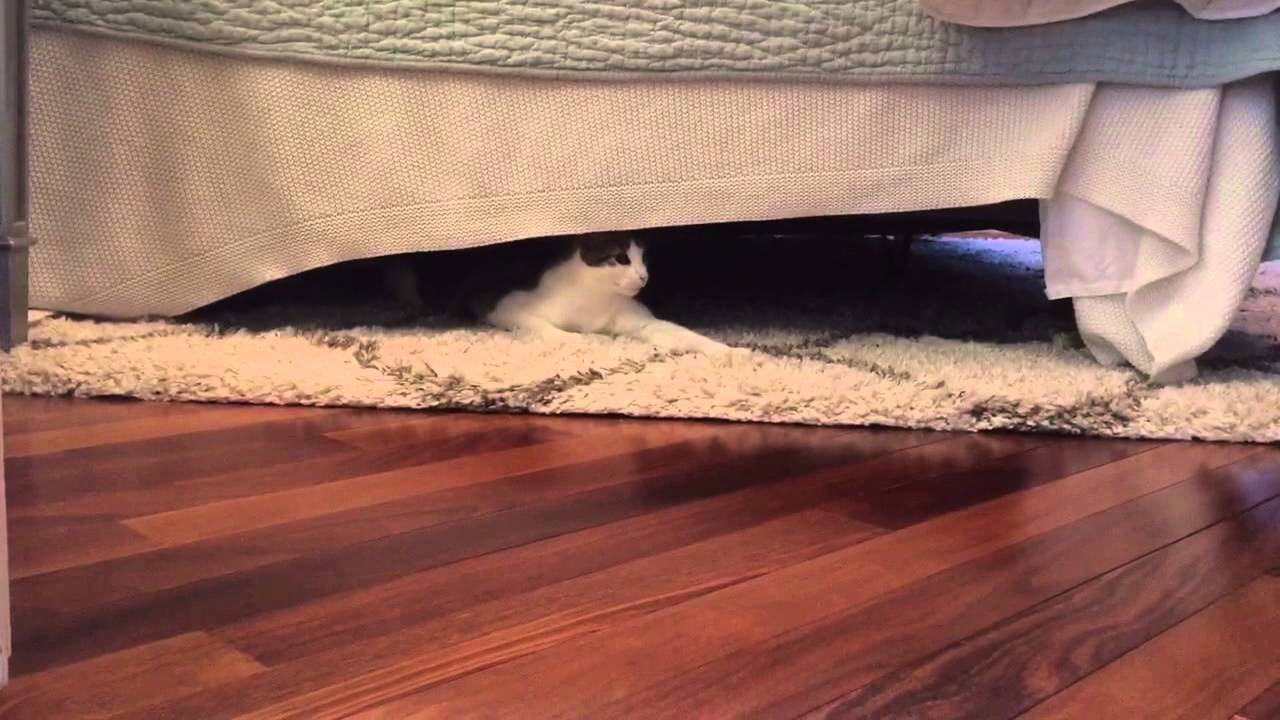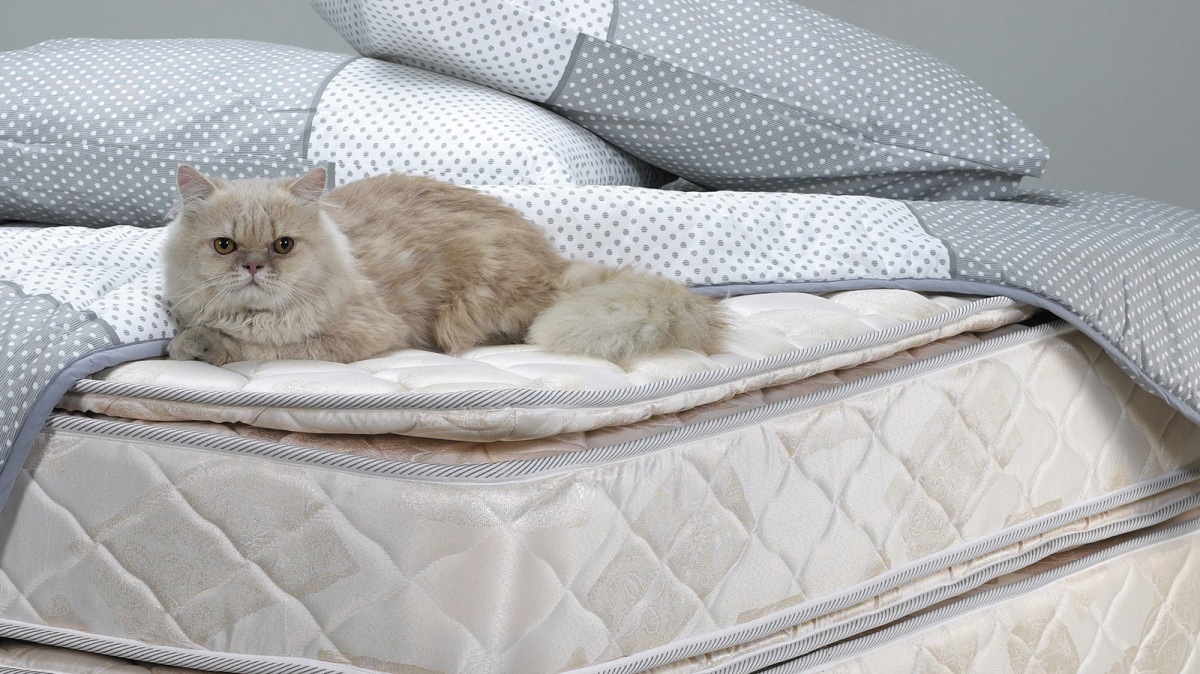Home>Furniture>Bedroom Furniture>How To Get A Cat Out From Under The Bed


Bedroom Furniture
How To Get A Cat Out From Under The Bed
Modified: February 23, 2024
Discover the best techniques for getting your cat out from under the bed. Find solutions and tips for dealing with bedroom furniture and feline hiding spots.
(Many of the links in this article redirect to a specific reviewed product. Your purchase of these products through affiliate links helps to generate commission for Storables.com, at no extra cost. Learn more)
Introduction
Welcome to our guide on how to get a cat out from under the bed. It happens to the best of us – your furry friend finds solace under the comforting confines of your bed and refuses to come out. Whether it’s due to fear, unfamiliarity, or simply a desire for a private hideaway, coaxing a cat out from under the bed can be a perplexing task.
But fear not! We have compiled a list of effective strategies and tips that will help you navigate this often-challenging situation. By creating a calm environment, using tempting treats and toys, and utilizing gentle persuasion, you’ll soon have your feline friend back in the open!
So, let’s dive in and uncover the secrets to successfully getting a cat out from under the bed.
Key Takeaways:
- Create a calm environment, use tempting treats and toys, and seek assistance from another person to coax your cat out from under the bed. Patience and gentle persuasion are key to success.
- Provide alternative hideouts and consult with a professional if needed to help your cat feel secure and confident outside of their hiding spot. Respect their boundaries and build trust for a harmonious environment.
Read more: How To Get A Cat Out Of A Chimney
Step 1: Create a Calm Environment
Creating a calm and reassuring environment is essential when trying to coax a cat out from under the bed. Cats are sensitive creatures and can easily pick up on our emotions. If you’re anxious or stressed, your cat will likely feel the same way and be less likely to come out.
Here are a few tips to help create a calm environment:
- Keep the area quiet: Minimize loud noises, such as TV or radio volume, to avoid startling or overwhelming your cat.
- Dim the lights: Soft, dim lighting can create a soothing atmosphere and make your cat feel more secure.
- Use calming scents: Consider using synthetic pheromone sprays or diffusers designed to help cats relax.
- Offer a cozy hiding spot: Place a comfortable bed or blanket in another area of the room to entice your cat to come out and explore.
By creating a calm environment, you’ll help alleviate your cat’s anxiety and encourage them to venture out from under the bed.
Step 2: Use Tempting Treats
Who can resist the lure of a delicious treat? Cats, like humans, are often motivated by food. Utilizing tempting treats is a great way to entice your furry friend out from under the bed. Here’s how:
- Select irresistible treats: Choose treats that your cat finds particularly enticing. It could be their favorite flavor, texture, or aroma that captures their attention.
- Make a trail: Place a few treats leading from under the bed towards the area you want your cat to move towards. This creates a visual and olfactory trail that your cat will follow.
- Use treat dispensing toys: Invest in treat dispensing toys that encourage your cat to engage and play. These toys will dispense treats as your cat interacts with them, motivating them to come out from under the bed to retrieve their reward.
Remember to be patient and allow your cat to come out at their own pace. Don’t force them out or grab them abruptly. Instead, give them time to follow the trail of treats and feel comfortable emerging from their hiding spot.
Tempting treats can be a powerful tool in coaxing your cat out from under the bed, so be sure to stock up on their favorite snacks!
Step 3: Lure the Cat Out with Toys
Cats are naturally curious creatures, and toys can be a great motivator to lure them out from under the bed. Here’s how you can effectively use toys to entice your cat:
- Choose interactive toys: Select toys that require your cat’s engagement, such as wand toys or interactive puzzle toys. These toys will capture your cat’s attention and encourage them to come out and play.
- Use movement and sound: Opt for toys that mimic prey with unpredictable movement and enticing sounds. This will appeal to your cat’s innate hunting instincts and encourage them to leave their hiding spot.
- Play near the bed: Position yourself near where your cat is hiding and play with the toy. Gradually move the toy away from the bed, enticing your cat to follow and join in the fun.
Remember to be patient and gentle when using toys to lure your cat out. Avoid forcing them to interact with the toy or overwhelming them with sudden movements. Allow them to approach the toy at their own pace.
Playing with toys not only helps lure your cat out from under the bed but also provides them with mental stimulation and exercise. It’s a win-win situation!
Step 4: Utilize a Comfortable Carrier
When coaxing a cat out from under the bed, having a comfortable carrier can be incredibly helpful. A carrier provides a safe and secure space for your cat, making it easier to transport them to another area of the house or to a vet if necessary. Here’s how you can utilize a carrier effectively:
- Choose the right carrier: Select a carrier that is spacious, well-ventilated, and easy to open and close. Opt for carriers with soft bedding or familiar blankets that your cat can associate with comfort.
- Place the carrier nearby: Position the carrier near the area where your cat is hiding under the bed. This allows them to familiarize themselves with the carrier and perceive it as a safe space.
- Create a positive association: Encourage your cat to enter the carrier by leaving treats, toys, or their favorite blanket inside. You can also use pheromone sprays or calming scents to make the carrier more inviting.
- Gradually introduce the carrier: If your cat is particularly fearful of the carrier, start by allowing them to explore it without closing the door. This helps them associate it with positive experiences.
- Seek professional assistance: If your cat refuses to enter the carrier or becomes extremely anxious, consider seeking help from a professional, such as a veterinarian or animal behaviorist, who can provide guidance and support.
A comfortable carrier can provide a sense of security for your cat and make the transition out from under the bed smoother. Remember to be patient and allow your cat to enter the carrier at their own pace.
Try using a toy or treat to lure the cat out from under the bed. You can also try gently coaxing them out with a soothing voice and slow movements. Avoid reaching in and grabbing them, as this can cause stress and fear.
Read more: How To Get Stains Out Of A Bed
Step 5: Seek Assistance from Another Person
When coaxing a cat out from under the bed becomes challenging, it can be helpful to enlist the assistance of another person. Having an extra pair of hands and a calming presence can make the process smoother. Here’s how you can utilize the help of another person:
- Choose a calm and familiar person: Select someone whom your cat is comfortable with and trusts. This person should have experience handling cats and be patient and gentle.
- Coordinate your actions: Communicate with the other person to ensure you both are on the same page. Plan how you will approach the situation and work together to lure the cat out from under the bed.
- Use gentle persuasion: Have one person softly call the cat’s name or make soothing noises to encourage them to come out. The other person can provide gentle strokes or scratches to reassure the cat and build trust.
- Offer treats and toys: Each person can take turns using treats and toys to entice the cat out from under the bed. This helps create a positive and engaging environment that encourages the cat to come out.
- Be patient and supportive: It’s essential to remain calm and patient throughout the process. Understand that every cat is different, and it may take time for them to feel comfortable enough to leave their hiding spot.
Seeking assistance from another person can provide additional support and create a more relaxed atmosphere for your cat. Remember to work together and stay positive throughout the process.
Step 6: Try Using a Soft Voice and Gentle Persuasion
Cats are sensitive to their environment and respond well to a soothing voice and gentle persuasion. This step involves using your voice and body language to communicate comfort and encouragement to your cat. Here are some tips to try:
- Speak softly: Use a calm and gentle tone of voice when addressing your cat. Avoid shouting or using a harsh tone, as this can cause further stress and frighten your cat.
- Call your cat by name: Speak your cat’s name in a reassuring manner. This can help capture their attention and build a sense of trust between you and your feline friend.
- Offer gentle strokes: If your cat allows, slowly and gently stroke their back or head. This can help them feel more comfortable and secure while under the bed.
- Use positive reinforcement: When your cat makes even the slightest progress, such as poking their head out, offer praise and rewards. This positive reinforcement will encourage them to continue exploring and ultimately come out from under the bed.
- Avoid sudden movements: Sudden movements or gestures can startle your cat and cause them to retreat further under the bed. Move slowly and deliberately to avoid triggering their instinct to hide.
Remember, patience is key. Cats are independent creatures, and it may take time for them to feel comfortable enough to come out from under the bed. By using a soft voice and gentle persuasion, you can create a calming atmosphere and build trust with your feline companion.
Step 7: Provide Hideouts in Other Areas of the House
If your cat is consistently seeking refuge under the bed, it may be helpful to provide alternative hiding spots in other areas of the house. This step aims to create additional safe and secure spaces where your cat can retreat to, reducing their reliance on hiding under the bed. Here’s how you can go about it:
- Set up cozy spaces: Identify quiet corners or secluded areas in different rooms where your cat can feel comfortable. Place soft blankets, beds, or cat trees in these areas to create cozy hideouts.
- Use vertical spaces: Cats love to climb and perch on elevated surfaces. Consider installing cat shelves or providing tall cat trees where your cat can feel safe and observe their surroundings from a higher vantage point.
- Provide hiding options with covers: Some cats prefer partially enclosed hideouts. Offer covered beds, boxes, or tunnels where they can retreat and feel secure without being completely hidden from view.
- Make the hideouts appealing: Add familiar scents, such as your cat’s bedding or a spritz of synthetic pheromones, to make the new hideouts more inviting. You can also place toys or treats in these areas to further encourage exploration.
- Redirect attention with interactive toys: Keep your cat engaged and distracted by providing interactive toys, scratching posts, or puzzle feeders in the designated areas. This helps redirect their focus from hiding under the bed to more stimulating activities.
By providing alternative hideouts, you give your cat options for feeling safe and secure throughout the house. This can reduce their inclination to seek refuge under the bed and promote a healthier and more confident environment for your feline companion.
Step 8: Consult with a Veterinarian or Animal Behaviorist
If all attempts to get your cat out from under the bed have been unsuccessful or if your cat’s behavior persists, it may be beneficial to seek professional guidance from a veterinarian or animal behaviorist. These experts can provide valuable insights and tailored advice to address your specific situation. Here’s why consulting with a professional can be helpful:
- Identification of underlying issues: A veterinarian or behaviorist can conduct a thorough evaluation of your cat’s health and behavior to identify any underlying medical or psychological issues that may be contributing to their hiding behavior.
- Customized behavior modification plans: Professionals can develop personalized behavior modification plans targeted towards your cat’s specific needs. These plans may include desensitization techniques, environmental enrichment strategies, or medication, if necessary.
- Expert advice and support: Veterinarians and behaviorists have extensive knowledge and experience in working with cats. They can provide you with expert advice, answer your questions, and support you throughout the process of helping your cat overcome their fear or anxiety.
- Peace of mind: Consulting with a professional can give you peace of mind knowing that you are taking the right steps to address your cat’s hiding behavior. You can also ensure that any underlying medical conditions are properly diagnosed and treated.
Remember, every cat is unique, and there may be specific factors at play that require professional intervention. Don’t hesitate to reach out to a veterinarian or behaviorist to ensure the well-being and happiness of your beloved feline companion.
Read more: How To Get Fleas Out Of A Bed
Conclusion
Coaxing a cat out from under the bed can be a challenging task, but with patience, creativity, and a gentle approach, it is possible to encourage your furry friend to come out and explore the world beyond their hiding spot. By following the steps outlined in this guide, you can create a calm environment, use tempting treats and toys, utilize a comfortable carrier, seek assistance from another person, use a soft voice and gentle persuasion, provide alternative hideouts, and consult with a professional if needed.
Remember, it’s essential to respect your cat’s boundaries and allow them to come out at their own pace. Avoid using force or excessive pressure, as this can cause further stress and hinder the process. Building trust and creating a positive association with the areas outside the bed will go a long way in helping your cat feel comfortable and secure.
If you find that your cat’s hiding behavior persists or if you are concerned about their well-being, don’t hesitate to consult with a veterinarian or animal behaviorist. These professionals can provide the necessary expertise and guidance to address any underlying issues and assist you in creating a harmonious and happy environment for your cat.
With patience, understanding, and a supportive approach, you can successfully encourage your cat to venture out from under the bed and enjoy all the wonders that their home has to offer.
Frequently Asked Questions about How To Get A Cat Out From Under The Bed
Was this page helpful?
At Storables.com, we guarantee accurate and reliable information. Our content, validated by Expert Board Contributors, is crafted following stringent Editorial Policies. We're committed to providing you with well-researched, expert-backed insights for all your informational needs.













